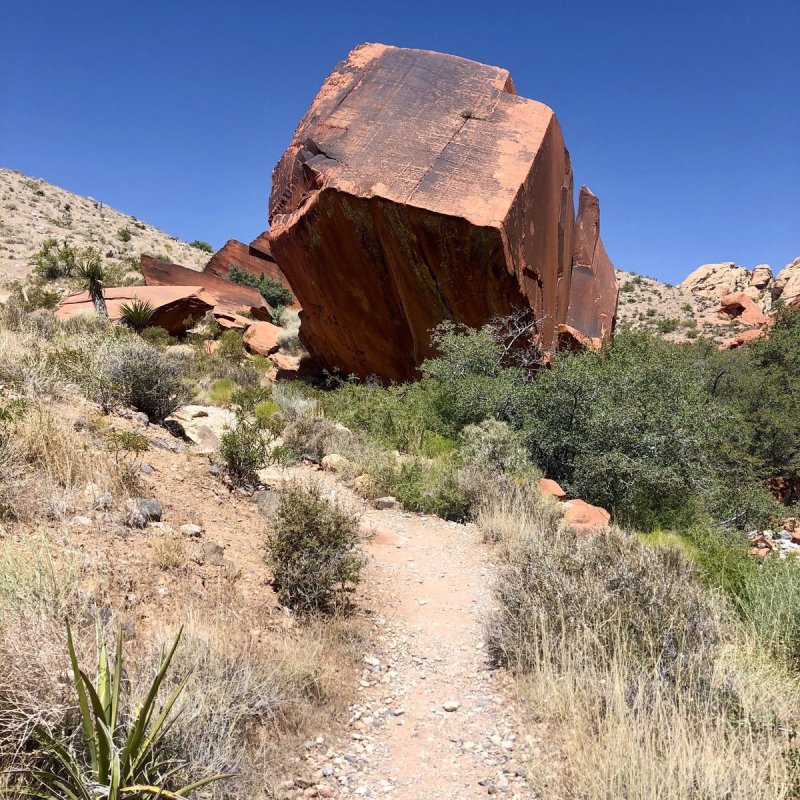
So, you want some city lights on your next trip, but you’re also yearning for nature and spectacular views?
Videos by TravelAwaits
Well, if you’re planning a trip to Las Vegas, the good news is that you don’t have to choose. You have world-famous city lights available on the Las Vegas Strip, but also the gorgeous Red Rock Canyon virtually at your doorstep.
At just a half hour or so from Las Vegas, the Red Rock Canyon National Conservation Area offers a true getaway within a getaway.
For more than a million visitors a year, the red cliffs and shady gorges of the recreation area serve as a respite from the hustle and bustle of Vegas — a place to unwind in nature and get in an aerobic workout at the same time.
While hiking is the premier activity in Red Rock Canyon, the park is also situated within convenient reach of the Las Vegas community of Summerlin, with its luxurious resorts, stellar shopping, and varied sporting events.
On a recent visit to Las Vegas, I spent a night in Summerlin and enjoyed the community’s more laid-back feel and somewhat easier driving than in Las Vegas. To get the most out of a visit to Red Rock Canyon, I recommend staying at least one night in Summerlin.
As with any Las Vegas-area destination, expect hot temperatures at Red Rock Canyon in the summer months, but mild weather in the winter, spring, and fall. The best months to visit are April and May, when the average high temperatures are in the high 60s to mid-70s, or September and October, when temperatures are in the 70s to mid-80s.
Here are nine of the best things to do in the Red Rock Canyon area.

1. Take In The Scenic Drive
Whether in a car or on a bike, the Scenic Drive in Red Rock Canyon offers a great overview of what the park has to offer. Along the 13-mile route, you will pass by numerous scenic overlooks, a host of trailheads, and some of the most stunning scenery Nevada has to offer.
It’s important to remember, though, that the Scenic Drive is a one-way route. I recommend stopping whenever an overlook or trailhead piques your interest. If you do miss a point of interest, you’ll have to catch it on a second pass through the area.
If you’re up for a 13-mile bike ride, cycling the route is a great, leisurely way to take in the views. Bikes are allowed on the Scenic Drive, but not on the canyon trails.

2. Hike Calico Hills
While Red Rock Canyon offers 26 different trails, one of Nevada’s most spectacular hikes can be found along the Calico Hills Trail, which takes in beautiful red bluffs and shady gorges.
There are several ways to access the trail, but I loved the access at the second Calico Hills trailhead along the Scenic Drive. The hike starts with a steep staircase down and continues along a picturesque dry creek bed.
At anywhere from 2 to 6 miles (depending on where you get on the trail), Calico Hills is rated as easy to moderate and takes between 1 and 3 hours to complete.

3. Climb Ice Box Canyon
As the name implies, Ice Box Canyon is known for its cool shade in the midst of the area’s hot rocks. “The narrow canyon rarely sees sunlight, and the cool water and air pouring down from the mountains keep it significantly cooler than the open desert,” says the Red Rock Canyon website.
With a rating of strenuous, the Ice Box Canyon Trail is not for the faint of heart. It rises steeply from the trailhead off the Scenic Drive, and the trail surface consists mostly of rock — starting with small pebbles and transitioning to large boulders. The views are stellar, though, and the hike is worth the effort. The 2.2-mile route takes about 2 hours to complete.
4. Meander Lost Creek
If you are visiting Red Rock Canyon in the winter or spring, you could happen upon the phenomenon of a desert waterfall along the Lost Creek — Children’s Discovery Trail off the Willow Spring Loop.
The waterfall is a seasonal happening, usually during the winter snowmelt or times of rainfall. It is most likely to occur between December and April. Online sources describe it as pouring from an overhang at the back of the box canyon.
But even without water, the Lost Creek Trail offers a taste of a variety of desert flora and wildlife. It also includes towering views. The 0.8-mile trail is rated as easy to moderate and takes about an hour to complete.

5. Read The Ancient News
Petroglyphs (prehistoric rock art) are sprinkled throughout Red Rock Canyon. The distinctive rock carvings hint at the scene that played out in the canyon 800 years ago. Exhibits that explain the Paiute culture are available at Red Rock Canyon’s visitor center.
Close-up looks at the petroglyphs are available at Petroglyph Wall, located off the Willow Spring Picnic Area. It’s a short, easy trail that takes about 20 minutes to complete. Other petroglyphs can be seen on the Calico Hills Trail, an easy-to-moderate route that takes 1 to 3 hours to complete.
6. Rock Climb If You Dare
The day I hiked the Calico Hills Trail, I was fascinated by several rock-climbing groups who were scaling the steep cliffs bordering the trail. Their echoing voices could be heard giving directions as the climbers hung from ropes high above me.
The canyon’s website notes that climbing is becoming increasingly popular, and routes are available for both beginner and advanced climbers. “Great boulders and sheer rock faces bring climbers from around the world,” the website says. More information is available on the Bureau of Land Management’s website.
Even for visitors who, like me, are not interested in trying rock climbing, watching the feat take place is a fun diversion along the trails.

7. Check Out The Overlooks
Although the trails are the main feature at Red Rock Canyon, don’t forget to stop at the overlooks that are spaced conveniently along the route.
I found the overlooks to be great sources of information about the history of the canyon, as well as wonderful spots to stop for photographs.
A sign at one overlook explained that the rolling hills in the distance were once sand dunes. “If you could travel back in time, about 180 million years, you would find yourself standing in a vast field of towering red sand dunes that stretched across much of the Southwest,” it said. In front of a massive sandstone hill, the sign offered a powerful geology lesson.
8. Stop By The Visitor Center
Located at the entrance to the Scenic Drive, the Red Rock Canyon Visitor Center also offers a wealth of information about the history of the canyon, its geology, and the trails that are available.
The center features both indoor and outdoor exhibits with plant specimens and a live desert tortoise habitat.
I recommend stopping at the center before you start the Scenic Drive for inspiration about which stops to make along the loop route.

9. Discover Summerlin
As an alternative to lodging in Las Vegas, an overnight stay in Summerlin makes the Red Rock Canyon an even easier drive of about 10 minutes. It also offers a change of pace from the usual Vegas scene.
The midsize Las Vegas suburb has a definite feeling of being a newly developed town, and I learned that it was founded in the early 1990s and has since grown rapidly with a population of families and retirees.
Although the first residents moved into Summerlin in 1991, the city has roots that go back more than a half century, with none other than early-20th-century tycoon Howard Hughes giving it an added mystique.
Summerlin’s website notes that Hughes acquired a 25,000-acre parcel along the then-barren western rim of the Las Vegas Valley in 1952 for a reported $3 an acre as a possible relocation for his California-based business concerns. He ultimately chose not to relocate, and the land stood unused for decades.
Today, Summerlin is bustling with a vibrant downtown area, several casino resorts, and a minor-league ballpark.
Lodging options to check out in the Summerlin area include the Red Rock Casino Resort & Hotel, a five-star resort that features deluxe accommodations, concerts, and events; the JW Marriott Las Vegas Resort & Spa with its luxurious Spa Aquae; and Element, a boutique hotel.
Myriad shopping and dining opportunities are available in downtown Summerlin, a walkable open-air mall setting that features a mix of local shops and restaurants and a huge selection of national chains. In all, the downtown features more than 125 stores and dozens of restaurants.
Downtown Summerlin is also the site of the Las Vegas Ballpark, home of the Las Vegas Aviators, a minor-league baseball team in the Pacific Coast League.
For another entertainment option, Wet‘n’Wild Las Vegas — a water park that features a host of waterslides, a lazy river, and a children’s area — is about a 15-minute drive from Summerlin.
